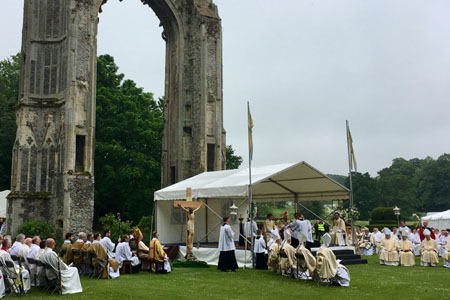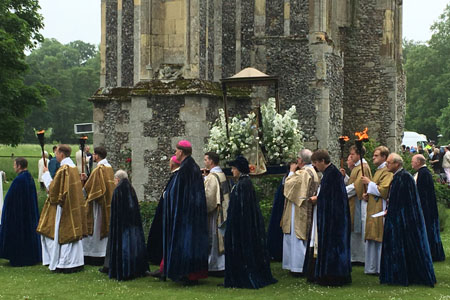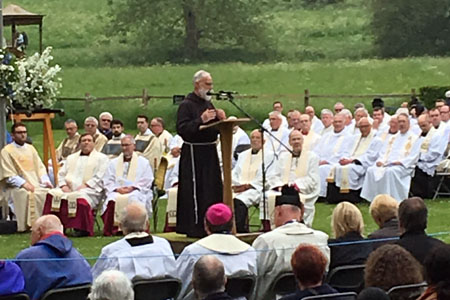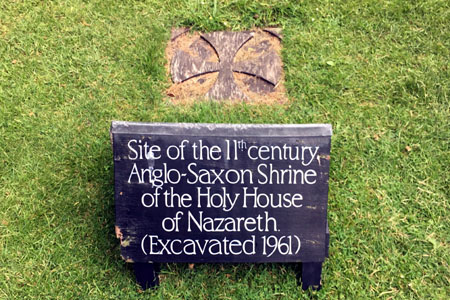| |
 |
 |
 |
| Comment on this report, or find other reports. |
 |
| Our Mystery Worshippers are volunteers who warm church pews for us around the world. If you'd like to become a Mystery Worshipper, start here. |
 |
| Find out how to reproduce this report in your church magazine or website. |
|
|
| 3176: National Pilgrimage, Shrine of Our Lady of Walsingham, England |
 |
 |
 |
Mystery Worshipper: Columba's Currach.
The church: National Pilgrimage, Shrine of Our Lady of Walsingham, Little Walsingham, Norfolk, England.
Denomination: Church of England (independent of any diocese).
The building: Legend has it that in 1061 the Virgin Mary appeared to Richeldis de Faverches, the lady of Walsingham Manor, and told her to build a replica of the house where the Angel Gabriel had announced to Mary that she would be with child. But construction did not go smoothly (the legend goes on to say) until one night, when Lady Richeldis was awoken by the sound of singing outside her window. She looked out to see a construction crew of angels just finishing up work on the completed house. Soon thereafter a priory was built nearby, the Priory of the Annunciation of the Blessed Virgin Mary. The priory and Holy House were visited by countless pilgrims, including Cardinal Wolsey, the Dutch scholar Erasmus, and several kings, including Henry VIII. But piety did not stop Henry from ordering Walsingham destroyed in 1538. The Holy House was burned to the ground, and today only a plaque marks the spot where it stood. The ruined east end of the priory, and some other parts, can also be seen. Each year the National Pilgrimage takes place on the grounds of the ruined Walsingham Priory, with the altar being set up in front of the east end.
The church: The Shrine of Our Lady of Walsingham is a curious creature. Both the Roman Catholic Church and the Church of England maintain various parts. It is not a parish church, although it has close ties with the local parish. Nor is it a religious house, although it does include a community of the Sisters of St Margaret.
The shrine's special charisma is to cater to pilgrims. To this end, they run several pilgrimages and retreats ever year. Many more pilgrims visit individually or in parish groups.
The shrine provides for the temporal needs of the pilgrims, including catering and accommodation (and even a disco in the case of the Youth Pilgrimage). For their spiritual needs, the shrine has four masses a day, as well as regular opportunities for confession, eucharistic adoration, healing prayers, and sprinkling with holy water, prayer, and of course various Marian devotions.
The neighbourhood: Little Walsingham has always been a religious sort of place. For a period of time between the Reformation and the 20th century, it was presumably a fairly typical north Norfolk village. It certainly isn't any more. The great majority of local businesses seem to cater to the pilgrim trade. There are shops selling incense, vestments, devotional objects, and religious books. Slightly more typical are the pubs and the tea shops, although most English villages of this size are not nearly so well served.
There are several religious buildings of note, but the most splendidly eccentric church of all belongs to the Orthodox. The Chapel of the Seraphim is in fact a former railway station to which were added an iconostasis inside and an onion dome outside.
The cast: A cast of thousands! I exaggerate, but not by that much. The principal concelebrant was the Rt Revd Martin Warner, Bishop of Chichester and a member of the College of Guardians of the Shrine of Our Lady of Walsingham. He was joined by over 100 concelebrants, of whom about 10 were bishops. The concelebrants were assisted by four deacons.
The preacher was Padre Raniero Cantalamessa, O.F.M.Cap., Preacher to the Papal Household.
An unnamed sister from the Sisters of St Margaret led the Rosary. The final portion of the service was led jointly by the Rt Revd Graham James, Anglican Bishop of Norwich and Honorary Guardian of the Shrine, and the Rt Revd Alan Hopes, Roman Catholic Bishop of East Anglia.
The Revd Kevin Smith, Priest Administrator of the Shrine, made announcements and read a letter of greeting from the Archbishop of Canterbury. The Rt Revd Philip North, Bishop of Burnley and Master of the Guardians of the Shrine of Our Lady of Walsingham, also said a few words.
Completing the cast were assorted others, including a verger, a team of servers from Goldthorpe in South Yorkshire, a choir (whose provenance was not listed), an honour guard of army cadets, and six women who led the intercessions. About two dozen becassocked seminarians from St Stephen's House, Oxford, and the College of the Resurrection, Mirfield, served as sidesmen.
Other practical services were provided by uniformed attendants of the St John's Ambulance Corps and by a British sign language interpreter.
The date & time: Monday, 29 May 2017, 12.00pm.
What was the name of the service?
Solemn Concelebrated Mass, Sermon and Procession. The mass had been preceded by a Forty Hours Devotion in the shrine church and an ecumenical vigil of prayer in the Walsingham parish church.
How full was the building?
The service took place in an open field, so the concept of fullness doesn't really apply. It was difficult to estimate how many were there; I would say perhaps a few hundred.
Did anyone welcome you personally?
We drove, so we were welcomed by the parking attendants, who also extracted a parking fee from us!
Was your pew comfortable?
Not terribly comfortable, no. We had been told to bring our own collapsible chairs, rugs or ground seats. My party and I spread a picnic blanket on the springy North Norfolk earth. Pilgrims in wheelchairs, as well as the hearing impaired, had a special area reserved for them near the altar.
How would you describe the pre-service
atmosphere?
When we arrived, it was a hive of activity, including mic checks, last minute rehearsals, etc.
Less immediately visible, but proudly mentioned in the service book and later in the announcement, was that a group of priests and laypeople of both the Anglican and Roman Catholic churches had been keeping a vigil of prayer before the Blessed Sacrament, exposed in the shrine church next door, for forty continuous hours before the service, The Forty Hours Devotion, based on the belief that Christ's body remained in the tomb for forty hours, is a traditional Catholic one, although less common these days than it was a generation ago. The vigil at Walsingham was part of the ecumenical prayer initiative "Thy Kingdom Come," which was begun by the Archbishop of Canterbury and is supported by the Cardinal Archbishop of Westminster, amongst other Christian leaders.

What were the exact opening words of the
service?
"Mary of Walsingham, mother of Jesus, pray for thy dowry, the land that we love ..." (the first verse of the first of four entrance hymns).
What books did the congregation use during the
service?
A bespoke 40-page booklet containing the words for the liturgy, all the hymns, practical information, and even advertisements for businesses (although only those selling items of a religious nature).
What musical instruments were played?
A truly terrible electric organ. When everything worked well, it just sounded silly, saccharine, and schmaltzy. When it didn't work well, which was often the case, it cut out, producing dreadful static noises. The microphones for the cantor and choir were similarly problematic.
Did anything distract you?
Compared to the norms of English Christianity, Walsingham makes little distinction between the sacred and the secular, the serious and the silly. Consequently, I don't know if any of the following should really be counted as distractions: wondering if it was going to rain; scanning the crowd to see if I knew anyone; noting the remarkable possible variations of the same basic forms of clerical dress. The Roman Catholic Bishop of East Anglia wore less than his Anglican counterpart. The former was in cassock, rochet, and mozzetta; the latter was in cope and mitre. I think that each participant was dressed pretty typically according to his own custom, but it did mean the Anglicans looked distinctly more grand! A purist might call those distractions; I'd call them part of the experience.
Was the worship stiff-upper-lip, happy clappy, or
what?
It is impossible to talk about Walsingham worship without mentioning camp. I should emphasize that I mean "camp" in the sense described by Susan Sontag in her essay "Notes on Camp" rather than in the sense that is perhaps more common in England.
Sontag identifies several characteristics of "camp." Amongst these are "a large element of artifice" and "the spirit of extravagance." By this definition, Walsingham is camp. Really, very camp indeed. The whole place takes a sort of mischievous delight in knowingly transgressing the norms of bourgeois good taste that often characterize Anglican worship.
The hymnody mixes slushy Roman Catholic hymns with the vulgarly robust offerings of evangelical camp revivals (pun unintentional but deliciously apropos). To these are added the most extraordinary homegrown hymns that speak of the shrine's history with extreme devotion, sometimes dubious accuracy, and terrible scansion.
But for all this, it still feels deeply serious about its fundamental form of Catholic Christianity. Perhaps appropriately, if one were to strip away all of the campy additions, the basic rite is a recognizable Common Worship eucharist of a form very similar to the modern Roman rite.
Exactly how long was the sermon?
40 minutes. The sermon took place after mass and before the procession.
On a scale of 1-10, how good was the preacher?
9 – It would really be a pretty poor showing if the Preacher to the Papal Household gave a bad sermon. Perhaps to lower expectations, he began by saying that preaching here was much more difficult than preaching before the Pope, because there at least he could preach in Italian and didn't have to worry about being rained on!
In the end, though, he was good enough that I scarcely noticed the extreme length of his sermon, and the same was true for everyone else to whom I spoke about it.
In terms of delivery, this was a clear 10 out of 10, but in terms of content there were a few places where I didn't quite follow the line of his argument. He spoke fluent English, but with a distinct Italian accent that was fun to listen to. I also found it striking that he preached in his dark brown Capuchin habit, in contrast to the splendid vestments worn by the other clergy.
In a nutshell, what was the sermon
about?
Mary points us to Christ. She does so in a particular way – with hope. Hope is one of the three theological virtues mentioned by St Paul, but it is often forgotten. Mary is seen as an exemplar of hope. Even at the foot of the cross, looking at her son's agonizing death, she was not without hope.
We must share this hope too. We must hope even when the world seems hopeless. Even when God seems distant and incomprehensible, we can only pray: "Lord, I do not understand you, but I trust you." In the end, we share in the hope of Ezekiel, who foresaw the dry bones animated with life. And so we hope that the Spirit will animate the dry bones of our church and our society. But this hope demands that we take an active part, every day, in building up the kingdom of God on earth.

Which part of the service was like being in
heaven?
The whole atmosphere of the day was very close to heaven for me. One thing stood out in particular. At the end of the service, the two local bishops (Anglican and Roman Catholic) jointly blessed two icons: one to hang in the Anglican shrine and one to hang in the Roman Catholic shrine. After this, they both blessed the assembled congregation as well.
And which part was like being in... er... the other place?
The terrible organ, the possibility of rain (which in the end didn't come), and the fact that the nun leading the Rosary could not always reliably count to ten, were all part of the joy for me.
A much more seriously hellish element came from the realisation that many dear friends, better Christians than I, either won't go to Walsingham or feel less than wholly welcome when they do go. I did hear a misogynistic comment from a priest in the pub after the service, where the tone of his voice implied an objection to women that was not based entirely on theology. This certainly shouldn't be generalised to the view of the shrine or most pilgrims. But I can see why not everyone feels as welcome as I do.
What happened when you hung around after the service looking lost?
There was an interval (yes, the service had an interval) after mass and before the concluding sermon and procession, during which people who had brought their own lunches enjoyed them picnic-style. Nothing was provided for free. Then came the sermon. After that, the procession wound its way from the ruined priory out through some parkland, past the parish church, down the main street, and then back to the priory. One place it didn't go, interestingly, was the shrine church. One might call it a Rosary sandwich – the Rosary was recited, with a hymn verse sung after each decade (more or less – see above). There were protestors, and they did heckle, but they were also behind a fairly large cordon of police and event stewards. They did not distract me in the least!
How would you describe the after-service
coffee?
Tea and vespers were announced, but a very significant portion of the congregation, including my party, elected instead to go up the hill to the pub. We found it extremely full, and the atmosphere there was decidedly convivial. I noted, though, that the queue for ale drinkers was notably shorter than the one for people wanting wine or gin.
How would you feel about making this church your regular (where 10 = ecstatic, 0 = terminal)?
N/A – This is simply not possible. This service happens only once a year. Although the shrine church does have services year round, these are also very much aimed at pilgrims.
Did the service make you feel glad to be a
Christian?
Very much so. I don't think I've felt happier about it for quite a long time.

What one thing will you remember about all this in seven days' time?
The witness to Christian unity provided by the two bishops. |
|
|
 |
 |
 |
| We rely on voluntary donations to stay online. If you're a regular visitor to Ship of Fools, please consider supporting us. |
 |
 |
 |
| The Mystery Pilgrim |
 |
| One of our most seasoned reporters makes the Camino pilgrimage to Santiago de Compostela in Spain. Read here. |
 |
 |
 |
| London churches |
 |
| Read reports from 70 London churches, visited by a small army of Mystery Worshippers on one single Sunday. Read here. |
| |
|
|
|
|


